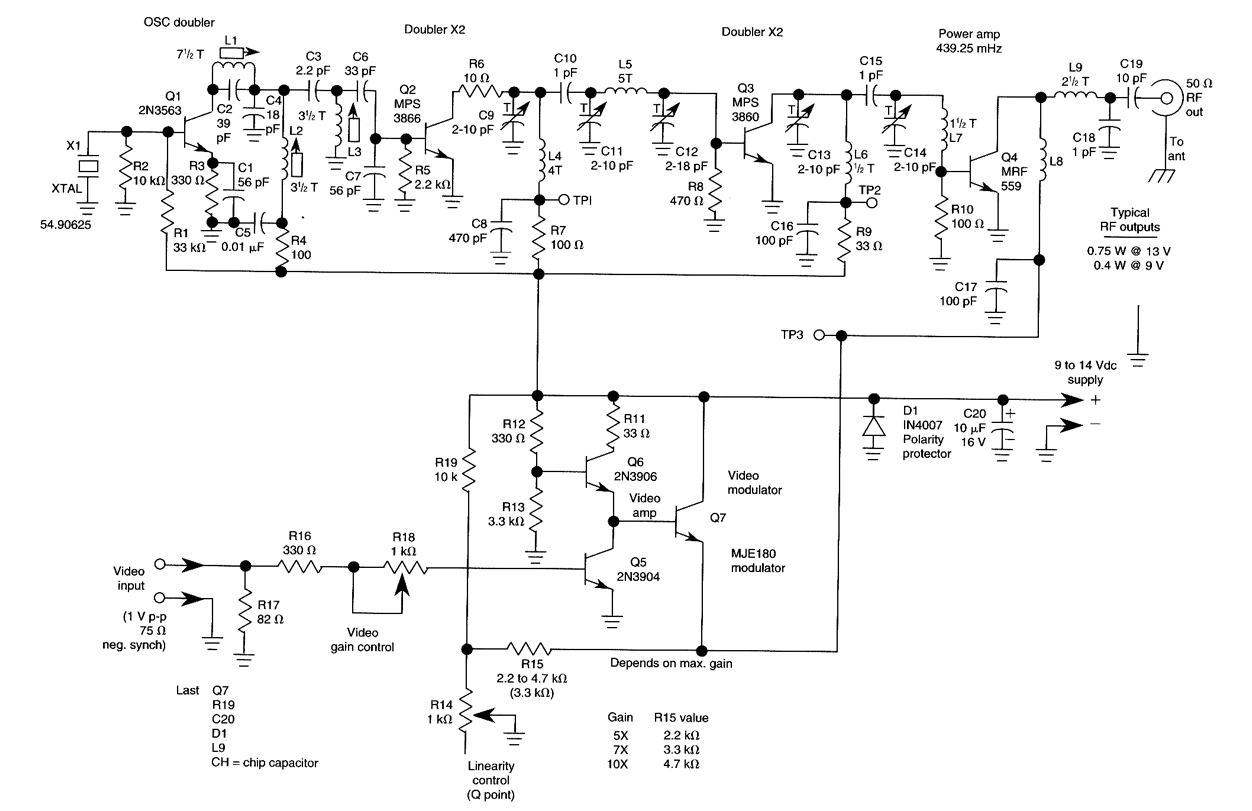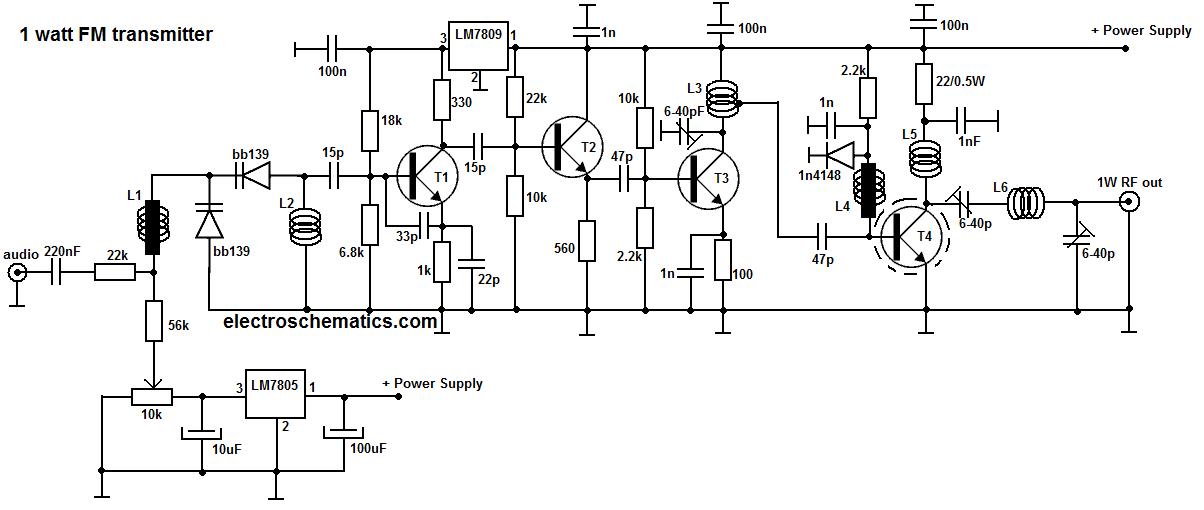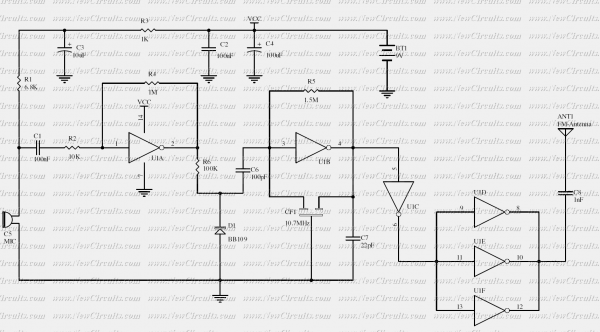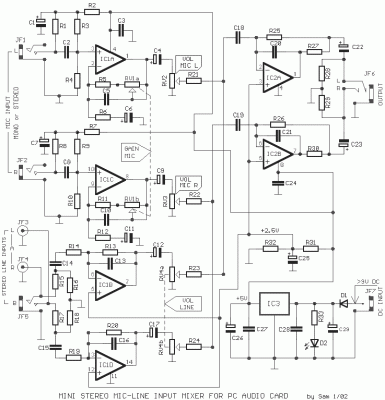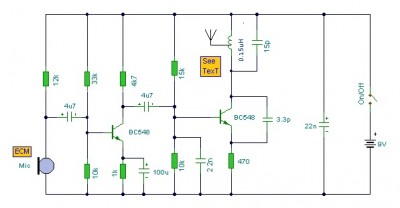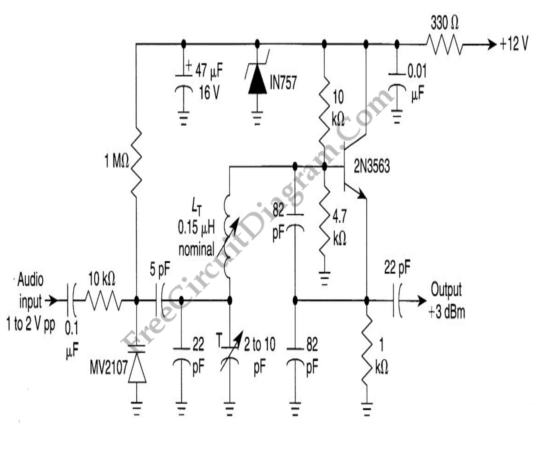
Mini FM Transmitter

This is a mini FM transmitter powered by two transistors and designed by Tony van Roon. This compact transmitter is straightforward to assemble, and its signals can be received on any standard FM radio. It has a range of approximately 1/4 mile (400 meters) or more, depending on line-of-sight conditions and obstructions. It is likely one of the simplest radio transmitters available, consisting of only five components, making it suitable for construction in limited spaces. This transmitter is ideal for science fair projects or other science-related applications that require short-range transmission. It operates on a voltage range of 1.5 to 3 volts. The accompanying diagram illustrates the FM transmitter circuit capable of transmitting up to 4 watts. The voltage supply for this circuit ranges from 12 to 16 volts, with a current consumption of 100 to 400 mA. The circuit operates within a frequency emission range of 88 to 108 MHz. The components list includes R1 and R2 (10K Ohm, 1/4 W), R3 (47 Ohm, 1/4 W), and C1 and C2 (1 nF). This low-cost and easy-to-build low-powered FM transmitter is claimed to have a range of approximately 300 feet when powered by a 9V supply and is expected to extend to around 400 feet when operated at 12V. Note that this transmitter should not be used as...
The mini FM transmitter described is a simple yet effective device for short-range audio broadcasting. The design, based on two transistors, allows for a compact and efficient layout, making it suitable for various applications, particularly in educational environments. The operational voltage range of 1.5 to 3 volts indicates that the transmitter can be powered by standard batteries, enhancing its portability and ease of use.
The circuit's construction involves a minimal number of components, which contributes to its low cost and ease of assembly. The use of resistors R1 and R2 at 10K Ohm helps in biasing the transistors properly, ensuring optimal performance. The 47 Ohm resistor R3 serves to limit the current through the circuit, protecting the components from potential damage due to excessive current flow. Capacitors C1 and C2, rated at 1 nF, are crucial for tuning the transmitter to the desired frequency range of 88 to 108 MHz, which corresponds to the FM broadcast band.
The transmitter's output power of up to 4 watts is significant for a device of its size, allowing it to achieve a range of approximately 400 feet with a 12V supply. This range is suitable for personal use, hobby projects, or educational demonstrations. The design's simplicity makes it an excellent choice for students and enthusiasts interested in exploring radio frequency transmission and electronics.
It is essential to adhere to local regulations regarding the use of FM transmitters, as unauthorized broadcasting can lead to legal issues. This device should be used responsibly and primarily for educational purposes or personal projects, ensuring compliance with applicable laws.This is a mini FM transmitter built and powered using 2 transistors, designed by Tony van Roon. This small transmitter is simple to build and its transmissions could be picked up on any common FM radio. It possesses a range of approximately 1/4-mile (400 meters) or even more, depending on the line-of-sight, obstructions by big.
This is probably t he simplest radio transmitter that you will find anywhere. It has a total of five parts and can be constructed into a very small space. It is great for science fair projects or other science related projects where short range transmission is useful. It runs on 1. 5 to 3 Volts, with small. The following diagram is the FM transmitter circuit with FM transmision up to 4W. Voltage supply for this circuit is 12-16V with current consumption of 100-400mA. This circuit works with frequency of emission range of 88-108MHz. Components List: R1, R2 = 10K Ohm (1/4 W) R3 = 47 Ohm (1/4 W) C1, C2 = 1nF. This is a low cost and easy build low powered FM transmitter. The range of the FM transmitter claimed about 300 feets when running at 9V supply. And the range claimed to be increased become about 400 feet when running it at 12V supply. Take a note that this transmitter should not be used as. 🔗 External reference
The mini FM transmitter described is a simple yet effective device for short-range audio broadcasting. The design, based on two transistors, allows for a compact and efficient layout, making it suitable for various applications, particularly in educational environments. The operational voltage range of 1.5 to 3 volts indicates that the transmitter can be powered by standard batteries, enhancing its portability and ease of use.
The circuit's construction involves a minimal number of components, which contributes to its low cost and ease of assembly. The use of resistors R1 and R2 at 10K Ohm helps in biasing the transistors properly, ensuring optimal performance. The 47 Ohm resistor R3 serves to limit the current through the circuit, protecting the components from potential damage due to excessive current flow. Capacitors C1 and C2, rated at 1 nF, are crucial for tuning the transmitter to the desired frequency range of 88 to 108 MHz, which corresponds to the FM broadcast band.
The transmitter's output power of up to 4 watts is significant for a device of its size, allowing it to achieve a range of approximately 400 feet with a 12V supply. This range is suitable for personal use, hobby projects, or educational demonstrations. The design's simplicity makes it an excellent choice for students and enthusiasts interested in exploring radio frequency transmission and electronics.
It is essential to adhere to local regulations regarding the use of FM transmitters, as unauthorized broadcasting can lead to legal issues. This device should be used responsibly and primarily for educational purposes or personal projects, ensuring compliance with applicable laws.This is a mini FM transmitter built and powered using 2 transistors, designed by Tony van Roon. This small transmitter is simple to build and its transmissions could be picked up on any common FM radio. It possesses a range of approximately 1/4-mile (400 meters) or even more, depending on the line-of-sight, obstructions by big.
This is probably t he simplest radio transmitter that you will find anywhere. It has a total of five parts and can be constructed into a very small space. It is great for science fair projects or other science related projects where short range transmission is useful. It runs on 1. 5 to 3 Volts, with small. The following diagram is the FM transmitter circuit with FM transmision up to 4W. Voltage supply for this circuit is 12-16V with current consumption of 100-400mA. This circuit works with frequency of emission range of 88-108MHz. Components List: R1, R2 = 10K Ohm (1/4 W) R3 = 47 Ohm (1/4 W) C1, C2 = 1nF. This is a low cost and easy build low powered FM transmitter. The range of the FM transmitter claimed about 300 feets when running at 9V supply. And the range claimed to be increased become about 400 feet when running it at 12V supply. Take a note that this transmitter should not be used as. 🔗 External reference
